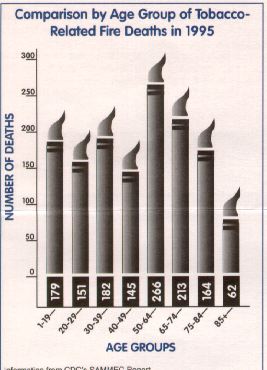A cigarette that doesn't cause fires - impossible?
No. In fact, very
possible. But, the tobacco industry won't produce and market such
cigarettes. Why?
In the early 1980's, spearheaded by Andrew McGuire,
head of San
Francisco General Hospital's trauma center, authorities on the federal
and state levels
began to challenge the cigarette companies to produce a fire-resistant
or
self-extinguishing cigarette. Congressman Joe Moakley (D-MA) led an
effort to gain passage
of legislation to require such fire-safe cigarettes; an effort that
produced two study
commissions to investigate the feasibility of such cigarettes.
The tobacco companies denied that a fire-resistant
cigarette was
feasible. Claiming that "the experimental fire-retardant
cigarettes their companies
had explored were too hard to draw on or had an unsatisfactory taste,
making them
commercially unviable," the companies refused to market fire-safe
cigarettes.
However, two sets of facts flew in the face of
these claims by the
tobacco companies. First, the Congressional study commissions in the
1980's concluded that
fire-safe cigarettes could be produced simply by increasing the
density of the tobacco
packed into the cigarette, reducing the circumference of the
cigarette, using a less
porous paper to wrap the cigarette in, and eliminating the citrate
additive that speeds up
burning. In addition, the fire-safe cigarettes could be produced with
the same yields of
tar, nicotine and carbon monoxide as regular brands of cigarettes.
These cigarettes were
fire-safe because they would either self-extinguish before igniting
furniture or bedding,
or they would not burn hotly enough to ignite adjoining furniture.
Second, the tobacco companies own secret research
had demonstrated that
it was possible to produce fire-safe cigarettes that consumers judged
to be as acceptable
in taste as regular brands. As early as
1981, Philip Morris, the giant of the tobacco
industry and producer of
Marlboro, the world's most popular cigarette, secretly conducted
Project Hamlet
(as in "to burn or not to burn...") to determine the
feasibility of producing a
fire-safe cigarette. This detailed research was kept secret from the
Congressional study
commissions, while the tobacco companies continued to deny the
feasibility of marketing a
fire-safe cigarette.
While continuing their denials, Philip Morris's own
research team had
evidence by 1987 that a less flammable version of Marlboro had been
found by a panel of
consumers to be as acceptable in taste as regular Marlboro cigarettes.
This was also
hidden from the public and the study commissions.
The tobacco companies continued to argue that a
fire-safe cigarette
would be a marketing disaster for them because the cigarette would be
too hard to draw on.
One tobacco company representative claimed that it would be like
trying to drink a milk
shake through five straws laid out end to end. However, Andrew
McGuire, who served on the
federal study commission, pointed out that the tobacco companies had
made the same claims
about reduced draw and poor taste before they introduced filter and
lowered-tar brands of
cigarettes.
As has been their pattern of denial and
obstruction, the tobacco
industry covered up the existence of information it had about
fire-safe cigarettes and
stalled any federal action that would have required such fire-safe
products. Why? Richard
Kluger, in his Pulitzer-prize-winning book, Ashes to Ashes,
stated, "the
[tobacco] industry was reluctant to risk introducing a manufacturing
technique that would
remind consumers of still one more way that smoking imperiled human
life," in spite
of the fact that it had the potential to save thousands of lives.
An equally important reason for their delays and
denials concerning
fire-safe cigarettes is their fear of legal liability. They
deny that fire-safe
cigarettes are feasible. Why? Because they fear that if they make
fire-safe cigarettes, it
will be an implied admission that their current cigarettes are not
fire-safe and cause
deaths from the fires they start. This could produce law suits against
the tobacco
companies from the families of victims of these fires, who would claim
that the tobacco
companies knew their cigarettes were not fire-safe, covered up that
information, and
intentionally did not produce a fire-safe cigarette that they knew
they were able to
produce.
Will fire-safe cigarettes ever be produced?
Possibly; but probably only
if the federal government requires it. And, these cigarettes still
won't be safe in terms
of health. But, as long as people smoke, shouldn't the cigarettes they
use be fire-safe so
that thousands of innocent victims don't get burned or die or lose
homes and possessions
from smoking-caused fires?
 Elderly Woman Killed After
Cigarette Ignites Blaze
Elderly Woman Killed After
Cigarette Ignites Blaze